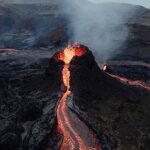By Joan H. Schiller, MD
As a physician, I have seen firsthand the devastating health problems that air pollution can inflict: asthma attacks, strokes, heart attacks, lung cancer, and more. By sharing the answers to some common questions about climate change and air pollution, I hope more people will understand the basics, care more about the issues, and do what they can to reduce air pollution and limit their exposure to it.
Why is the climate changing, and what are some of the health effects?
The climate is changing largely due to the burning of fossil fuels, which emits greenhouse gases such as CO2, methane, and nitrous oxide. How do these emissions bring about climate change? When the sun’s energy strikes the earth’s surface, some of it is absorbed and re-radiated back towards space as infrared heat. This re-radiated energy is partially captured and then itself re-radiated back down to the earth by greenhouse gases in our atmosphere. Without greenhouse gases we would have a frozen planet so they play a critical role in making our planet habitable. When we add to our levels of greenhouse gases by burning fossil fuels, they capture and re-radiate more energy back to the surface, warming us up more. Some greenhouse gases can stay in the atmosphere for over a thousand years, impacting the climate for many future generations.
The impacts of global warming on our health and safety are myriad: rising sea levels, catastrophic weather events, droughts, heat waves, wildfires, and flooding, which are occurring with increasing frequency and severity. In addition, global warming threatens food and water security, results in more vector-carried infectious diseases (like malaria and Lyme disease), and contributes to longer pollen seasons. The extreme heat due to climate change causes more heat-related deaths, particularly among the most vulnerable (the elderly, pregnant women, children, cancer patients, and people without indoor air-conditioning relief or those working outside).
Recent severe weather events such as hurricanes and flooding have shown us how vulnerable our healthcare system is. Infrastructure damage makes transportation difficult and communication hard. Damage to health treatment facilities, loss of access to medical records, inability to obtain medications, IV fluids, oxygen, and other supplies cause treatment interruptions in cancer patients, delay treatment for chronic disease such as diabetes or heart disease, and delay preventive medicine.
So, how is a changing climate different from air pollution?
Many of us intuitively know what air pollution is: the presence of chemicals or compounds in the air which are usually not present, and which have harmful effects. They can be very harmful indeed: 8.7 million deaths in 2018 were attributed to outdoor air pollution – one out of almost every five deaths that year, and three times the number of people who died from COVID in 2020. Air pollution is cutting years off the lives of billions of people.
Burning of fossil fuels not only emits greenhouse gases, but particulate matter (PM) as well. PM comes in two sizes: coarse and fine. Fine particles (PM2.5, particles smaller than 2.5 microns, or about 1/30th the width of a human hair) are particularly harmful. PM2.5 can come from natural sources, such as forest fires, or can be man-made, coming from burning fossil fuels in factories, power plants, and diesel and gasoline-powered motor vehicles. Other common pollutants include carbon monoxide, sulfur dioxide, methane, and hundreds of chemicals resulting from the burning of crude oil.
What kinds of health problems are associated with air pollution?
Both acute and chronic exposure to PM2.5 carry significant health risks. Acute, sudden exposure to high levels of PM2.5 can cause a decrease in lung function, resulting in asthma attacks, heart attacks, and strokes. Chronic, persistent exposure can exacerbate such diseases as COPD (chronic obstructive pulmonary disease), emphysema, bronchitis, and lung cancer, even in people who have never smoked.
Numerous studies have shown that in areas exposed to smoke from wildfires, for example, the hospitalization rate for asthma, COPD exacerbations, and cardiovascular disease goes up significantly. In fact, the 2015 Global Burden of Disease study lists air pollution as the fourth highest-ranking global mortality risk factor. Populations with pre-existing health issues, such as the elderly or people with respiratory diseases, heart problems, or lung cancer, are at an especially increased risk for harm from air-borne particulates.
But I am safe from air pollution when I am inside, right?
Actually, indoor air pollution is ranked as one of the top five environmental risks to public health and is due to a variety of causes, including burning of natural gas. Many of us use gas appliances in our homes, but “natural gas” is methane − a greenhouse gas. The burning of “natural” gas is associated with the release of many compounds, carbon monoxide and nitrogen oxides among them. In fact, cooking on gas can spike emissions of nitrogen dioxide and carbon monoxide to levels that would violate outdoor pollutant standards. According to the EPA, indoor pollution levels may be as much as 50 times higher indoors than outdoors. Children in particular are susceptible to air pollution due to their developing lungs and smaller body size; it is estimated that children in a home with a gas stove have a 24 to 42 percent increased risk of having asthma.
I know we want to protect the ozone layer, but am confused when I hear that ozone is bad for us.
Ozone in the upper atmosphere is “good” – it helps protect us from ultraviolet light from the sun. Ground-level ozone, on the other hand, is a form of air pollution, which is created when methane and nitrogen oxides react in the presence of sunlight and heat. Ozone contributes to what we typically experience as “smog” or haze, and ground-level ozone exacerbates asthma, COPD, and other respiratory conditions.
Increasing temperatures make ozone pollution worse; during heat waves in urban areas, ground-level ozone pollution can be 20 percent higher than usual. It is estimated that in 2017, exposure to ozone caused an additional 254,000 deaths. You can protect yourself from the effects of ozone pollution by staying indoors with the air conditioning on during “bad air quality days” and avoiding pollen, which exacerbates many of the symptoms. You can find information on ozone levels and pollen counts from your local weather station.
In addition to asthma, COPD, strokes, heart attacks, and lung cancer, symptoms arising from air pollution include coughing, throat irritation, and congestion. Air pollution also causes adverse pregnancy outcomes, such as preterm birth, low birth weight, and stillbirth.
What does any of this have to do with climate change?
Air pollution and climate change are closely related:
- They both come from the burning of fossil fuels. As noted above, climate change is largely due to the production of greenhouse gases from the burning of fossil fuels, which is also a major source of air pollutants.
- Climate change also has caused more and hotter forest fires and created a longer fire season. The smoke produced by these wildfires can affect the air thousands of miles away, resulting in hundreds of deaths and thousands of hospitalizations from heart and lung disease.
- The increase in the number of hot days from the accumulation of atmospheric greenhouse gases can lead to an increase in ground-level ozone, increasing smog and decreasing air quality.
- Many air pollutants can result in changes in the climate by affecting the amount of incoming sunlight that is reflected or absorbed by the atmosphere, with some pollutants warming and others cooling the Earth. These short-lived climate-forcing pollutants (SLCPs) include methane, black carbon (a component of PM2.5), ground-level ozone, and sulfate aerosols. For example, black carbon, or soot, reduces the reflectivity of snow and ice, thus making those areas more susceptible to melting with a resultant warming of the surroundings, while particulate sulfates cool the earth’s atmosphere.
What can be done?
The good news is that the problem of air pollution and climate change is being recognized more and more. President Biden recently announced a goal for having 50% of new U.S. vehicles be electric by 2030, and the EPA and Department of Transportation announced new, more stringent fuel emissions standards. The major infrastructure bills being introduced in Congress this year have funding allocated for promotion of electric cars and charging stations and for ways to reduce the amount of carbon that many companies and industries pump into the air.
The Clean Air Act of 1970, one of America’s first and most influential modern environmental laws, illustrates how effective legislation can be; it reduced the number of many pollutants, resulting in the reduction of acid rain from sulfur dioxide, and protection of the ozone layer in the stratosphere by banning chlorofluorocarbons (CFCs).
What can I do?
As individuals, we can do our part by switching to electric vehicles or modes of transportation that are not as dependent on fossil fuels, such as biking, walking, or public transportation. Even if we cannot afford electric cars, we can switch to more electrical appliances, from leaf blowers to hot-water heaters to electric stoves. C-Change Conversations offers other ideas for climate action here.
The Bottom Line?
Air pollutants and climate change from the burning of fossil fuel are two sides of the same coin. Both directly damage our health and when combined they make each other more deadly. We deserve better. Let’s do what we can to lower greenhouse gas emissions and slow global warming for both cleaner air and better health.
Dr. Joan H. Schiller is a widely published medical oncologist who is internationally recognized for her work in lung cancer clinical research. She is also passionate about climate change and its impact on health. She is the author of Global Warming, COVID-19, and Lung Cancer: Why Lung Cancer Doctors Should Care about Climate Change and Why Oncologists Should Care About Climate Change. She is currently a board member of the Lung Cancer Research Foundation, Adjunct Professor at the University of Virginia, and a member of Oncologists United for Climate and Health (OUCH).


